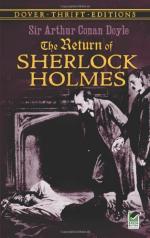“But now came the real difficulty of the inquiry. The order of the English letters after E is by no means well marked, and any preponderance which may be shown in an average of a printed sheet may be reversed in a single short sentence. Speaking roughly, T, A, O, I, N, S, H, R, D, and L are the numerical order in which letters occur, but T, A, O, and I are very nearly abreast of each other, and it would be an endless task to try each combination until a meaning was arrived at. I therefore waited for fresh material. In my second interview with Mr. Hilton Cubitt he was able to give me two other short sentences and one message, which appeared—since there was no flag—to be a single word. Here are the symbols. Now, in the single word I have already got the two E’s coming second and fourth in a word of five letters. It might be ‘sever,’ or ‘lever,’ or ‘never.’ There can be no question that the latter as a reply to an appeal is far the most probable, and the circumstances pointed to its being a reply written by the lady. Accepting it as correct, we are now able to say that the symbols stand respectively for N, V, and R.
“Even now I was in considerable difficulty, but a happy thought put me in possession of several other letters. It occurred to me that if these appeals came, as I expected, from someone who had been intimate with the lady in her early life, a combination which contained two E’s with three letters between might very well stand for the name ‘Elsie.’ On examination I found that such a combination formed the termination of the message which was three times repeated. It was certainly some appeal to ‘Elsie.’ In this way I had got my L, S, and I. But what appeal could it be? There were only four letters in the word which preceded ‘Elsie,’ and it ended in E. Surely the word must be ‘come.’ I tried all other four letters ending in E, but could find none to fit the case. So now I was in possession of C, O, and M, and I was in a position to attack the first message once more, dividing it into words and putting dots for each symbol which was still unknown. So treated, it worked out in this fashion:
.M .Ere ..E SL.NE.
“Now the first letter can only be A, which is a most useful discovery, since it occurs no fewer than three times in this short sentence, and the H is also apparent in the second word. Now it becomes:
AM HERE A.E SLANE.
Or, filling in the obvious vacancies in the name:
AM HERE ABE SLANEY.
I had so many letters now that I could proceed with considerable confidence to the second message, which worked out in this fashion:
A. ELRI. ES.
Here I could only make sense by putting T and G for the missing letters, and supposing that the name was that of some house or inn at which the writer was staying.”




